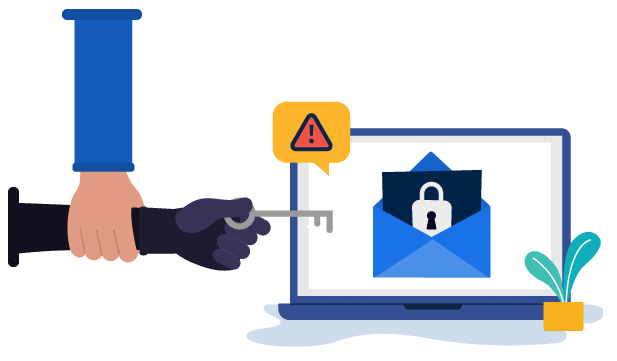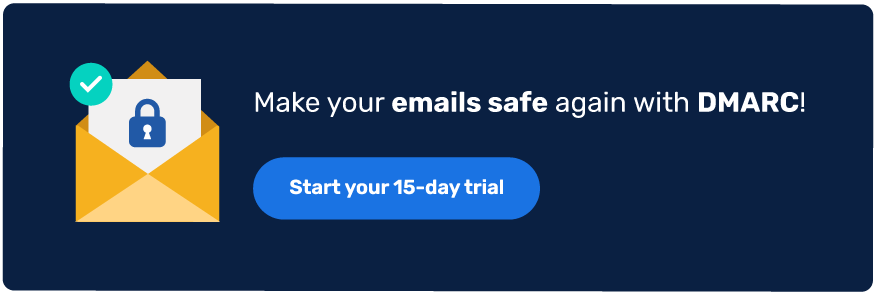Email spoofing security is an important addition to your email’s security posture. Here’s why: email spoofing is a form of internet fraud. It’s when a hacker sends an email that appears to be from a legitimate company or person, and they use this fake email to trick the receiver into exposing sensitive details. This can happen in two ways: either by forging your email address or by creating their own fake email address that looks similar to yours.
Email spoofing security prevents attackers from stealing sensitive information by stopping impersonation attempts at their nascent stages.
You can learn about the latest phishing statistics here to assess the threat landscape yourself!
Key Takeaways
- Email spoofing can deceive individuals into revealing sensitive information through fraudulent messages that appear legitimate.
- Organizations are particularly vulnerable to email spoofing attacks, which can lead to significant data breaches and financial loss.
- DMARC is essential for businesses to implement as it helps authenticate emails and prevent forgery attempts.
- Identifying spoofed emails includes checking the sender’s domain, looking for obvious errors, and verifying unfamiliar links before clicking.
- Becoming a DMARC MSP provides organizations with tools to enhance email security and protect their customers from fraud.
Email Spoofing Explained in Simple Terms
In simple terms, email spoofing is when someone sends an email that looks like it’s from you, but it’s actually not. They fake the “From” address to trick the recipient into thinking the message is coming from a trusted source like your company, a bank, or a friend, when it’s really from a scammer.
How Email Spoofing Works?
As a form of identity theft, in spoofing, an attacker disguises the email address as coming from someone else. Because email is one of the most trusted forms of communication, it’s common for people to ignore any warning signs and open emails from unknown senders. That’s why a lack of email spoofing security can affect businesses so deeply.
When an attacker disguises an email address as coming from your business or one of your partners, they’re able to trick employees into opening and responding to phishing messages. These phishing messages can contain malicious links that lead to viruses or other malware, or they can simply ask for personal information that could be used in future attacks against your company.
How Hackers Spoof Email Accounts
Hackers use spoofing to disguise their identity to access your email account. Spoofing can be done in many different ways, but here are the most common methods:
Open SMTP Relays
If you send emails from your home computer or network, your system likely has an open SMTP relay. This means anyone can connect to your server and send emails as if they were you.
Display Name Spoofing
Display name spoofing is relatively easy to spot. Hackers will change the display name on an email account to something they want, such as “[email protected].” The problem is that it’s easy to tell if the display name has been changed — all you have to do is hover your mouse over the sender’s name.
If it says “security” rather than “John Smith,” you know it’s spoofed.
Legitimate Domains Spoofing
In this case, hackers set up a fake website similar to a legitimate one (such as @gmail.com instead of @googlemail.com). They send out emails asking people for their login details or other personal information, which they then use themselves or sell on the black market (the former is known as phishing).
Uncode Spoofing
Unicode spoofing is a form of domain name spoofing in which a Unicode character that looks similar to an ASCII character is used instead of an ASCII character in the domain name.
To fully grasp this method, you must be familiar with the encoding schemes used in domains where non-Latin characters (such as Cyrillic or umlauts) are used.
Punycode, a method for converting Unicode characters to an ASCII Compatible Encoding (ACE) representation of the Latin alphabet, hyphens, and numerals 0 through 9, was developed so that it may be used. Also, the Unicode domain is shown by many browsers and email clients.
Spoofing via Lookalike Domains
A lookalike domain is an exact copy of an existing domain name registered by an attacker who intends to send spam or phishing attacks using this domain name as if your company owned it.
Because they are so similar to your domain name, users can only tell the difference between their domains if they carefully read everything in the email header because they are so similar to your domain name.
Social Engineering Techniques
Social engineering is a form of hacking that involves tricking people into giving away sensitive information.
Hackers often pose as someone else (a friend, family member, or co-worker) to get information like passwords or credit card numbers out of unsuspecting victims through phone calls or emails.
Why is Email Spoofing Dangerous?
Businesses are particularly vulnerable because they are often targeted by hackers looking for sensitive information such as credit card numbers and social security numbers. If someone gets access to this kind of data through phishing attacks, which is essentially what email spoofing leads to, it could cause a lot of damage to the business owner!
2 common ways businesses can be affected by email spoofing is when someone sends phishing emails from their own domain or uses a lookalike domain to impersonate the business.
How Spoofed Emails Can Harm You
Spoofed emails are like Pandora’s box, as a high percentage of cyber attacks (some studies suggest over 70%) begin with a malicious email, and many data breaches involve social engineering tactics like spoofing. They can unleash a whole heap of trouble, resulting in dangerous consequences such as:
- Spoofing can lead to phishing emails being sent on your behalf to steal sensitive information like login and credit card details.
- Spoofing can result in BEC attacks. Cybercriminals impersonate legitimate company executives to wire money or share confidential information.
- Spoofed emails can lead to malware and spyware distribution, and ransomware attacks.
- Repeated spoofing attacks on your domain can lead to significant reputation damage and reduced brand trust, potentially causing customers to become reluctant to open even legitimate emails. This can also involve trademark or intellectual property violations. Such attacks can result in substantial financial losses for organizations.
- Continued successful spoofing attempts can lead to identity theft and unauthorized access to accounts.
- Organizations failing to secure their email domains may face regulatory fines or legal consequences under several compliance frameworks.
- Spoofed emails targeting suppliers or vendors can compromise business relationships, leading to fraudulent transactions, data breaches, or operational disruptions.
Secure Agaisnt Spoofing with PowerDMARC!
Email Spoofing Detection & Prevention

If you receive an email from someone whom you trust but whose name doesn’t appear in the “From” field, be wary: It may be a spoofing attack!
Recognizing the Signs of Email Spoofing
- Check the sender’s domain name – is it the same one you’re used to seeing? If not, it could be a fake.
- Does the message have any typos or grammatical errors? If so, it might be a fake.
- Does the message contain links that seem out of place or don’t match what you’re expecting? If so, it might be a fake.
- Hover over links in emails, and check where they go before clicking on them.
- Check with your IT department at work or school if you’re not sure about an email that’s come through your inbox.
- You’re seeing emails in your ‘sent box’ that aren’t sent by you.
- You’re receiving replies to emails not initiated by you.
- Your password has changed, and it was not done by you.
- People are receiving fraudulent emails in your name.
- Finally, to gain email spoofing security at your organization, deploy the right tools and solutions to protect your domain from forgery.
Preventative measures
1. Email Authentication Methods
- SPF (Sender Policy Framework): One of the basics of email authentication protocols, when used alongside DKIM and DMARC, helps prevent email spoofing. SPF helps you authorize the permitted email senders for your domain.
- DKIM (DomainKeys Identified Mail): An email authentication protocol to sign all outgoing messages to help prevent email tampering.
- DMARC (Domain-based Message Authentication, Reporting & Conformance): DMARC is an email authentication protocol that allows organizations to protect themselves from spoofing and phishing attacks. It works as a layer on top of SPF and DKIM, enabling domain owners to publish a policy for how receiving mail servers should handle messages that fail SPF or DKIM authentication and alignment checks (e.g., quarantine, reject or deliver them).
Note: DMARC can protect your domain against spoofing attacks that involve direct-domain spoofing. It is ineffective against cases that involve lookalike domains.
2. Additional Security Measures
Educate Employees
Employees play a crucial role in preventing email spoofing, as they are often the first line of defense against attacks. Organizations should provide training on recognizing phishing attempts, verifying sender details, and responding appropriately to suspicious emails.
Enable BIMI
BIMI(Brand Indicators for Message Identification) is a visual email security feature that requires an enforced DMARC policy to display your brand logo directly in recipients’ inboxes. BIMI builds trust and credibility, making it easier for recipients to spot a fake. To properly configure BIMI, your domain needs an enforced DMARC policy (p=quarantine or p=reject) and a BIMI-compliant SVG logo.
Use AI-based Email Security Tools
AI-powered Threat Intelligence technology helps detect and prevent cyber attacks before their onset. Using email security tools that integrate this technology is a modern solution to combat cyber fraud.
What to Do If You’re a Victim of Email Spoofing
If you suspect your email address has been used in a spoofing attack, you can follow the best practices given below for handling domain spoofing incidents:
- Check DMARC reports for spoofing attempts
- Strengthen your DMARC policy (e.g., moving from none to quarantine or reject)
- Notify any affected users and internal teams
- Report spoofing incidents to your email provider or security teams
- Use tools to track and analyze spoofing attempts
FAQs
1. What’s the difference between email spoofing and phishing?
Spoofing is the process of forging a legitimate sender’s email address. Phishing is the process of trying to trick unsuspecting victims into exposing sensitive information. Spoofing is often used in Phishing.
2. Can free email providers (Gmail, Yahoo) prevent spoofing?
Free email providers like Gmail and Yahoo can detect spoofed emails sent to their users, but they can’t stop others from spoofing your domain.
3. Is DMARC enough to stop all spoofing attacks?
No, DMARC is only effective against direct-domain spoofing attacks. It cannot prevent lookalike domains.
4. How do I check if my domain is being spoofed?
To check if your domain is being spoofed, enable DMARC reporting for your domain. These comprehensive reports provide insights into unauthorized sending attempts, authentication failures, and email deliverability issues.
Final Words
While email spoofing is one of the most persistent threats in the cyber world, businesses can implement the right tools and strategies to prevent it. Through consistent monitoring, following email authentication best practices, and investing in anti-spoofing tools, a majority of the risk can be mitigated.
By preventing email spoofing, you can protect your brand from large-scale financial losses and the next big data breach. It’s time to get proactive by signing up for a free DMARC trial, and start protecting your domains against spoofing!

- Top 7 Best Email Verification Tools for Secure Delivery - November 28, 2025
- CNAME vs A Record: Which DNS Record Should You Use? - November 18, 2025
- DMARC MSP Case Study: How PowerDMARC Secures Amalfi Technology Consulting Client Domains from Spoofing - November 17, 2025




